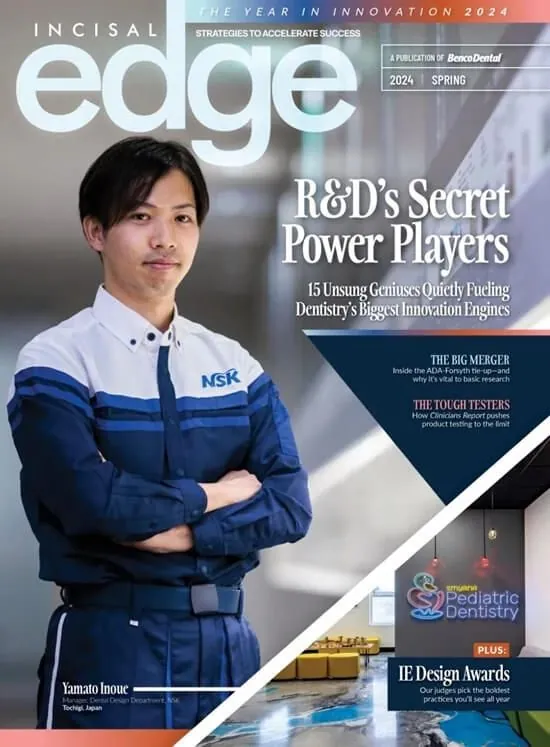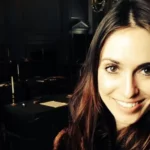THE 2016 EDISON AWARDS
INNOVATIONS & INNOVATORS
By Elizabeth Dilts and Kristie Ceruti
The world is awash in technological change; you need only look around you to notice how quickly the objects of our daily lives are transforming themselves — and us. Dentistry is no different. Indeed, the pace of change in our field in just the last few years has been nothing short of breathtaking. With that in mind, we’ve once again partnered with the Edison Awards to honor the top disruptors and boldest innovators who are remaking modern dentistry at light speed. No one can foresee what lies ahead, but one thing is certain: Our industry will continue to change as fast as its greatest minds can make it happen.
GUMCHUCKS BY ORALWISE
INVENTORS: Jeremy Stewart and Keith Allen, president of OralWise
AGES: Stewart 40; Allen 44
EDUCATION: Stewart: did not attend college; Allen: bachelor’s degree in marketing, University of California, Los Angeles
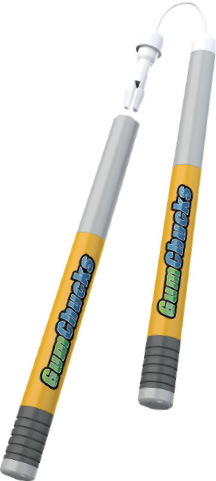
GumChucks are the brainchild of free-spirited inventor Jeremy Stewart, and Ninja Vitis is part of GumChucks’ marketing campaign for kids. Stewart originally created the device with a couple of dowel rods between which he strung floss — a tool he used to floss without having to put his hands in his mouth. But when he teamed up with OralWise President Keith Allen, Allen saw that GumChucks could be an important tool to promote flossing to children, as well as a simple and effective method to pitch the task to weary adults.
“It’s faster, it’s easier and it can wrap around teeth in a perfect C shape that makes it more effective,” Allen says. “At the very end of the day, when you barely want to brush your teeth, it makes flossing easy and takes half the time.”
When you’re done, simply press a button on the handles to eject the floss tips straight into the trash. “People don’t like unraveling wet, gross floss from purple fingertips and throwing it in trash,” Allen says. GumChucks are cleaner, too, and their reusable handles are dishwasher-safe.
Though the name and kids’ marketing campaign are lighthearted, Allen maintains that flossing with GumChucks has major benefits: It disrupts biofoam beneath the gum line better than other methods such as water floss, for example.
Since the product launched in late 2012, Stewart has moved on to other pursuits, leaving Allen to spearhead the business. The device has taken off in North America, Europe and now Japan.
“It’s great to see people getting it,” Allen says. “We’re riding this wave of consumer awareness that oral health and oral hygiene are major parts of your overall health.”
SHADOWLESS HEADLAMP
INVENTOR: Dr. Kim Gichun
AGE: 58
EDUCATION: Bachelor’s degree in mechanical engineering, Korea Aerospace University, South Korea; medical degree from Inje University College of Medicine, South Korea
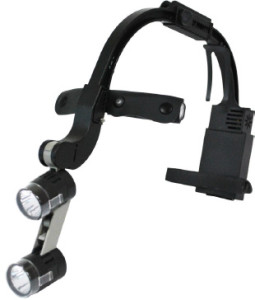
Patented by Dr. Gichun when he was a medical student, the device is a twenty- first-century take on the head mirrors doctors wore in the 1960s. The imperfect mirrors were meant to reflect light from the overhead lamp to illuminate shadows cast by doctors’ hands.
Dr. Gichun’s featherweight headlamp, which weighs just 100 grams, does a more effective job by using dual beams of white light to disperse shadows and reduce strain on the doctor’s nose and forehead. Battery-powered and wireless, it can last up to 12 hours on one two-hour charge.
“He is a true inventor,” says JK Kim, chief executive officer of 3D Dex, which sells Dr. Gichun’s headlamp. (Kim serves as a spokesman for Dr. Gichun, who does not speak English.) “Before he was a doctor, he filed for many patents while he was a student.”
After finishing his engineering and then medical degree, Dr. Gichun opened his own family doctor’s office in 2002 in Gwang Nyung City, South Korea. Eager to pursue development of his headlamp and other inventions, he closed the practice in 2006 and with $100,000 launched his own development company.
He introduced the first generation of his shadowless headlamp later that year, selling it to former medical-school classmates who were willing to try it out. But the device had a flaw: The LED light often burned out within the first four months, requiring Dr. Gichun to replace the light, and often the whole device, each time.
The replacements would have bankrupted him, JK Kim says, if not for a medical- products trade show in Seoul, where he sold some 20 headlamps in a single day, enabling him to fund and develop a much longer-lasting LED light. Boosted by its popularity, he began touring the trade-show circuit, exporting to Japan, and hired a team of marketers.
Since 2009, Dr. Gichun’s headlamp business has doubled each year; the product is now exported to Japan, Russia and the United States.
SMARTMOUTH MOUTHWASH
INVENTOR: Rachel Nottingham Colosimo
AGE: 33
EDUCATION: Bachelor’s degree in industrial design, Cleveland Institute of Art
Less might often be more, but for product designer Rachel Nottingham Colosimo, less led to more work. Colosimo was the program leader of a team comprising specialists in design, engineering, prototyping, sourcing and brand-ing in a yearlong project to redesign the packaging of SmartMouth Mouthwash.
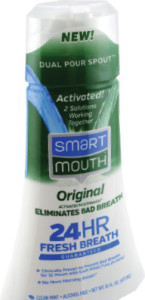
Users often complained, however, that they often ran out of one liquid before finishing the other, leading SmartMouth to look to Colosimo and the renowned product-design firm Nottingham Spirk.
“Consumers won’t tell us solutions to our problems,” says the 33-year-old Colosimo. “But they will tell us their problems, and that usually unfolds into our solution.” After months of designing dozens of packaging and spout concepts and testing them on themselves and consumers, the Nottingham Spirk team devised a one-box solution that distributes both liquids in the same amount at the same time.
SmartMouth’s new shrink-wrapped package binds the bottles together and uses one spout topped by a special lid that keeps the liquid in the spout separate.
The redesigned product with re-designed packaging hit shelves at an additional 13,000 stores nationwide in October: Walmart, Walgreens, Target and more. Thus far, Colosimo says, consumers seem quite happy with it — and she should know. She and her husband use the stuff daily. “I always like to test products when I first start working on them,” she says, and she did just that when the SmartMouth project kicked into gear. She loved the mouthwash itself, she says, but noticed the drawbacks of the double-bottle design.
Thanks to her team’s efforts, that’s no longer a problem. “Now, every time I go to the store and I see more than one bottle [of SmartMouth], I buy them all.”
MULTI AXIS SPIRAL SUCTION
INVENTOR: Dr. Dave Ronto
AGE: 42
EDUCATION: DDS, Loma Linda University School of Dentistry
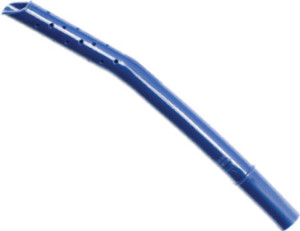
It occurred in 2010, after a long day of patient appointments and walk-in emer-gencies at his practice near Benton Harbor, Michigan. Dr. Ronto felt as though he’d spent half his time fighting to keep his suction tool from sticking to his patients’ mouths. He went to bed irritated and exhausted, only to wake up a few hours later. “It was like a bolt of lightning,” he recalls. “I sat up in bed and thought, ‘If I have to modify every blessed tube I ever get for my operatories, I’ll do it.’ ”
What Dr. Ronto calls a “dreadful night” was the in fact the start of a booming business making tips for suction devices that don’t stick to patients’ cheeks. The Multi Axis Spiral Suction is a tip for a high-volume evacuator that uses a barrel perforated with holes to distribute suction evenly without attaching to the tongue, cheek or soft tissue.
The barrel of the tip is slightly curved at such a precise distance from the patient’s mouth that an assistant can hold his or her wrist in a more comfortable straight position. The tip can reach as far back as the third molar, while remaining out of the dentist’s line of sight.
The tip took Dr. Ronto more than five years to begin making in bulk — during which time he graduated from poking holes in tubes he molded over a Bunsen burn-er to buying his first 60,000-pound tip-manufacturing machine.
Dr. Ronto, a hobby mechanic, now operates three such machines in a warehouse, just 10 minutes from his practice, that he and and a friend own. “I’ve always had a knack for the mechanical side of things,” Dr. Ronto says. “With this, I’m literally running the machine. I work with the wiring, do the math required, make sure the injection velocities are right, all of it.”
The hard work has paid off. Sales of Dr. Ronto’s Multi Axis Spiral Suction tip have doubled or tripled every month since last June.
ORAL-B PRO 5000 POWER TOOTHBRUSH WITH BLUETOOTH TECHNOLOGY
INVENTORS: Frank Kressmann, Peter J. Mason, Hansjoerg Reick
AGES: Kressmann 48; Mason 41; Reick 50

The brush connects with an app on your phone to record whether you’re over-brushing, under-brushing or just missed a
spot. “The problem we wanted to solve was to motivate and coach people to do a better job brushing,” Frank Kressmann, head of research and development for Oral-B’s Power Toothbrush, said in a 2015 interview.
Scrolling through the news on their phone in one hand and brushing their teeth with the other, users can flick over to the app to see which teeth need extra brushing — and get alerted if they start to brush too hard.
Hansjoerg Reick, Oral-B’s associate director for research and development, said the developers initially worried that users might think of the product as just a gadget and thereby fail to incorporate it fully into their daily life.
That concern proved unfounded. Kressman’s team has found that users’ average brushing time with the Power Toothbrush is two minutes and 16 seconds, more than twice as long as people typically spend brushing their teeth.
Might that be because users get distracted by playing with the app? Maybe. In addition to tracking how often you’ve flossed or brushed your tongue over the last month, it’ll also give you the weather, says Peter J. Mason, the company’s principal manager for oral-care industrial design.
For those of us who don’t floss often enough, the app also en-ables you to set reminders to do so. “Consumers like the motivation because they get better results,” Reick has said. “This is a real tool that improves oral health when people continue to use it over a long period of time.”
TRIOLOGY BY NOWSYSTEM
INVENTORS: Janice King and Dale Weintraub
AGES: King 64; Weintraub 65 EDUCATION: King: Bachelor’s degree in accounting, Pittsburg State University; Weintraub: Bachelor’s degree in business, the University of Kansas
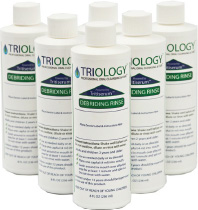
Dentists treating cancer patients at the University of Kansas who start them on the all-natural Triology mouth-cleaning system before their cancer treatment begins say the plant-based formula prevents patients from developing mouth sores.
Triology co-creators Janice King and Dale Weintraub never dreamed it might have that effect when they left their careers in accounting and retail, respectively, to begin their research 15 years ago.
“For patients who are experiencing their own health crisis, their immune system is so compromised,” says King, a former tax expert who began researching the Triology system with Weintraub in 2000. Periodontal disease can take hold, and conventional toothpastes and mouthwashes contain chemicals that are too much for vulnerable mouths to handle.
Triology is made of whole-plant extracts of aloe, sweet almond oil and wheat-grass grown in glacier fields, among others. The Triology system reintroduces key nutrients that are missing from humans’ modern-day diet to help naturally prevent chronic inflammation, the main cause of periodontal disease, King says.
Perfecting the regimen took the duo 10 years. Weintraub — who owned a fur-niture store before he shifted focus to Triology — says the pair tested “hundreds” of combinations to find a formula that was an effective antimicrobial and that did the least amount of damage to the mouth. “We know the healing properties of each individual ingredient and have been able to show antimicrobial effects,” he says. He and King are now working with the University of Kansas Medical Center’s Biosci-ence Business Incubator to get their product to dentists who treat cancer patients and those suffering from HIV/AIDS. Part of their pitch? Their outsider status.
“The aim of science is to seek the simplest answer to complex questions.
We worked inside the medical system and didn’t overcomplicate it,” King says. “Some of the greatest innovations come from people outside the industry.”
SOLEA BY CONVERGENT DENTAL
INVENTORS: Nathan Monty and Michael Cataldo
AGES: Monty 52; Cataldo 51
EDUCATION: Monty: Bachelor’s in mechanical engineering, Rensselaer
Polytechnic Institute; Cataldo: Bachelor’s in business, Columbia College
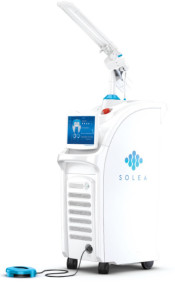
It would appear that the two are building their case. Last year, they rolled out an upgrade for their laser that makes it six times faster at cutting through hard and soft tissue.
More than 95 percent of dentists who use Solea, meanwhile, report that they do not have to numb their patients for the procedure. That’s because Solea shoots a strong-wavelength beam of carbon dioxide onto the tooth, casting a microscopic circular pattern shaped and pulsed by two moving mirrors. The mirrors can change the size of the pattern, adapting it and the pulse rate to achieve the fastest, most effective cutting method.
“Some of these patterns cut smoother and finer, and they’re all faster,” Cataldo says. “Dentists all report that this makes it even easier not to use anesthesia.” The laser’s pulse, a light tap-tap-tap on the tooth or gum, triggers a sort of shutdown at pain’s entry gates, he explains.
The new update, which dentists can downloaded to wireless handheld devices overnight, also introduced a periodontal application. Doctors can now insert a tiny tube into the perio pocket and beam the laser into the space below the gum line.
The perio application is a valuable addition, Cataldo posits, as its inclusion may help sway some dentists who balk at the laser’s $100,000 price tag. Although the majority of them will recoup that investment within a year, Cataldo says, the perio capability ups the ante on Solea’s appeal.
“It’s getting better and better,” he says. “We need to make it easier and easier for dentists to be successful with it.”
